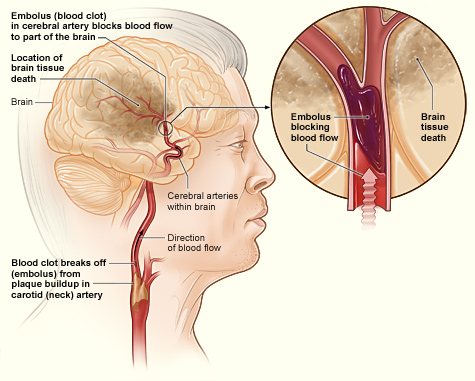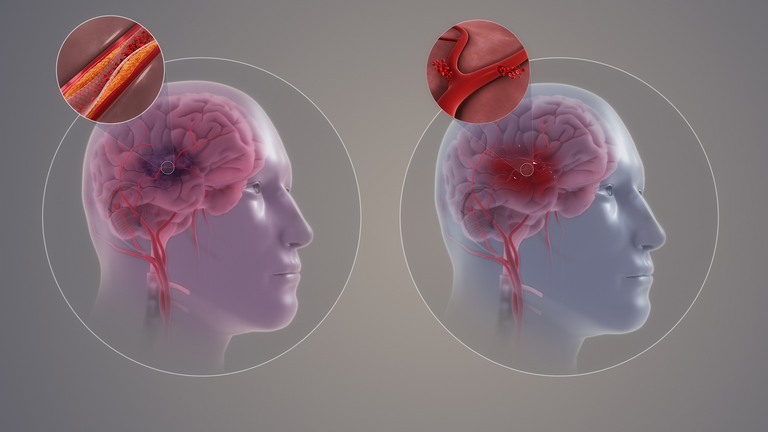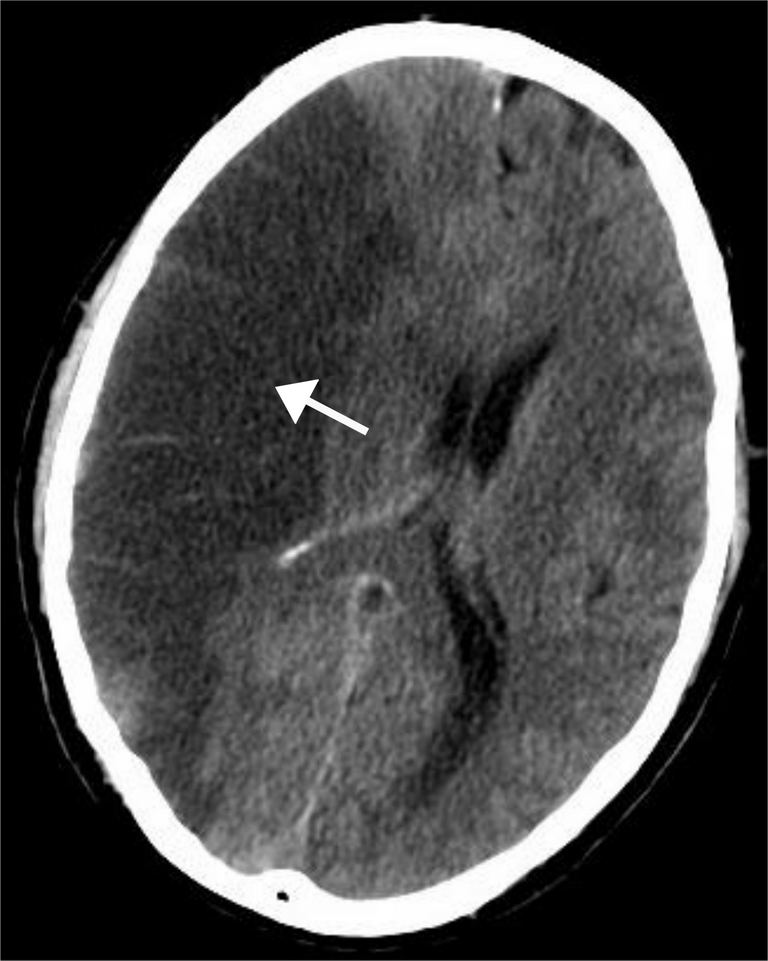
By Marvin 101 - Own work, CC BY-SA 3.0, Wikimedia
Now, What is a Cerebrovascular Accident?
Cerebrovascular Accident (CVA) is the medical term for what is commonly known as Stroke, which results from either a blockage or rupture of a blood vessel. This prevents blood flow to a portion of the brain and results in a stroke. There are crucial stroke warning signals that one should be aware of and on the lookout for. The prognosis is better if the patient obtains treatment more promptly since a stroke that goes untreated for too long might cause lasting brain damage.

By National Heart Lung and Blood Insitute (NIH) - National Heart Lung and Blood Insitute (NIH), Public Domain, Wikimedia
Types of Stroke
There are two basic types of cerebrovascular accident, or stroke: hemorrhagic strokes caused by blood vessel rupture, and ischemic strokes which is caused by a blockage in the blood vessel. Both kinds of strokes deprive a portion of the brain of blood and oxygen, which results in the death of brain cells.
Ischemic Stroke is the most frequent type of stroke and occurs when a blood clot obstructs a blood vessel, preventing blood and oxygen from reaching a portion of the brain. There are two possible outcomes for this. A clot that originates elsewhere in the body and lodges in a blood vessel in the brain is one way that an embolic stroke might happen. A thrombotic stroke, on the other hand, happens when the clot forms in a blood vessel inside the brain.
Haemorrhagic Stroke occurs when a blood vessel in the brain bursts, or bleeds. This blocks the flow of blood to a portion of the brain thereby resulting to a Haemorrhagic Stroke. Any blood vessel in the brain may have a hemorrhage, or it may happen in the membrane covering the brain.

By Scientific Animations, CC BY-SA 4.0, Wikimedia
What are the signs and symptoms of Cerebrovascular Accident (Stroke)
It's important to understand and identify the signs and symptoms of a stroke because the prognosis for a stroke will be better the sooner it is diagnosed and treated.
Symptoms of a stroke include:
lack of coordination and balance.
trouble communicating or comprehending others when they talk (as it happened in this man that was brought to our facility)
walking difficulties and lightheadedness.
Blurred or darkened vision, numbness or paralysis in the face, leg, or arm, most commonly on just one side of the body
an unexpected headache, especially one that is accompanied by nausea, vomiting, or lightheadedness
Depending on the person and the location of the stroke in the brain, the symptoms of a stroke might change. Even if they are not extremely severe, symptoms frequently occur quickly and may worsen over time.
People can remember the acronym "FAST" to assist them identify the most typical stroke symptoms:
F - Facial Deviation
A - Arm Weakness
S - Slurred Speech
T - Time is brain.

By INFARCT.jpg: Lucien Monfilsderivative work: Suraj - INFARCT.jpg, CC BY-SA 3.0, Wikimedia
What are the relevant investigations for this condition?
- Brain CT scans are used to distinguish between ischemic and hemorrhagic strokes and confirm the diagnosis of stroke. The earliest CT scan abnormalities in an ischemic stroke are noticeable within a few hours of the occurrence, however they may not be seen for many days or more.
- magnetic resonance imaging (MRI)
- random blood sugar is taken to rule out hypoglycemia coma and because it is a risk factor for stroke complications and has a bad prognosis.
- Electrocardiography
Additional investigations comprise;
- Chest X-ray, platelets, and full blood count
- A lumber puncture
- Lipid profile
- Serum Electrolyte/Urea/Creatinine
Management
First of all, the patient is resuscitated and given Intravenous fluid (normal saline). An Urgent Random Blood Sugar is then done and if the patient is unconscious, nasogastric tube and urinary catheter are then passed. The patient is placed on Nil per Ora for the first 48 hours and the blood pressure monitored carefully. Drugs like 20% mannitol, Intravenous Furosemide, Antibiotics if indicated are given. Thrombolytics and Antiplatelets (for ischaemic stroke) are also given. And then prophylaxis for deep vein thrombosis. A patient with haemorrhagic Stroke is ideally managed in the intensive care unit for close monitoring.

By Biswarup Ganguly, CC BY 3.0, Wikimedia
How can Cerebrovascular Accident be prevented?
A stroke can occur for a variety of reasons, such as diabetes, atrial fibrillation, and excessive blood pressure (high blood pressure).
Consequently, there are several steps you may take to lessen the risk of stroke as follows;
- Maintain a normal blood pressure level. Many people don't check their blood pressure. Please kindly check your blood pressure today.
- Reduce your consumption of cholesterol and saturated fat.
- Avoid smoking, and consume alcohol sparingly.
- Manage diabetes. Check your blood sugar regularly
- Keep a healthy weight.
- Exercise often.
- Consume a diet high in fruits and vegetables.
In conclusion, Cerebrovascular Accident (Stroke) is the 3rd most common cause of death worldwide. Therefore, the knowledge of the early signs and strict adherence to the preventive measures will greatly reduce the mobidity and mortality associated with this disease
Thanks alot for reading.
For further reading;
WHO
CDC
Congratulations @alidickson! You have completed the following achievement on the Hive blockchain and have been rewarded with new badge(s):
Your next target is to reach 300 replies.
You can view your badges on your board and compare yourself to others in the Ranking
If you no longer want to receive notifications, reply to this comment with the word
STOPCheck out the last post from @hivebuzz:
Thank you so much @hivebuzz . I appreciate
You're welcome @alidickson! Have a nice day 😊👍